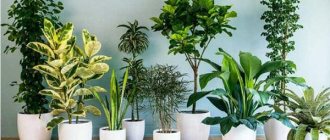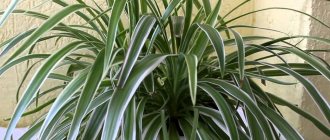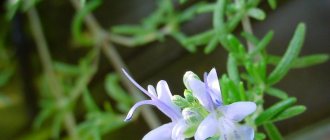Growing flowers in a personal plot is a fairly common occurrence. With the help of these ornamental plants you can completely transform the landscape and make it more comfortable for relaxation. Flowers are often bred not only for decoration, but also for medicinal purposes and for sale.
The most important thing in this process is to choose and equip the greenhouse for flowers correctly.
A wide variety of varieties are suitable for cultivation, including peonies in the form of lush bushes, roses, which can add charm and romance to any garden, asters and nasturtiums, nigella, violets, dahlias and many others. When choosing plants, they usually rely not only on their appearance, but also on the possibility of growing in specific climatic conditions, based on the rules of care. Today, greenhouses or winter gardens are used for this, and flowers are grown in special containers.
Technology of sowing and planting indoor plants
When planning to plant a flower, first of all you need to decide on the shape and size of the pot. To do this, the size of the crop and the degree of development of its root system are taken into account: the longer and wider it is, the more spacious the pot should be.
You also need to consider where you are going to place the flower. Pots are suitable for an open terrace or balcony, but for an ordinary city apartment, traditional pots or containers are most often chosen.
Note: Regardless of the type of pot you plan to plant, there should be drainage holes in the bottom of the pot to drain excess moisture. Place a tray under the pot into which excess water will drain. Without this condition, water will begin to accumulate near the roots of the flower, and the crop may die.
Planting technology also includes the selection of suitable soil (Figure 1). Each type of flower requires its own special soil, which will reflect natural soil conditions. The easiest way is to buy a ready-made soil mixture in a special store, but it is much more fun to prepare it yourself.
Classic soil for indoor crops consists of clay-turf soil with the addition of a small amount of compost, peat and high-quality sand. It is also advisable to add a small amount of charcoal, which will act as an organic fertilizer. To simplify the task of planting flowers for your home, here are step-by-step instructions for this process.
Figure 1. Proper planting of flowers in containers
Sowing or planting indoor plants is carried out as follows:
- Preparing the pot includes making a drainage layer (Figure 2). To do this, lay a layer of expanded clay, broken brick, moss or polystyrene on the bottom of the container. This layer will ensure air flow to the roots and prevent stagnation of moisture in the soil.
- is poured into the pot . The second part is left to cover the roots of the flower.
- The seedling is placed vertically in a pot , evenly distributing its roots inside the container. The roots should not protrude to the surface or be too crowded. If this does happen, you need to take a larger container.
- The pot is filled to the top with the remaining soil mixture and lightly compacted. After this, the flower needs to be watered and fed (if necessary), and placed in a permanent place.
It is important that both the soil itself and the root system must be moist. This will help the earthen coma to attach more tightly to the roots, and will make the acclimatization process in a new place faster.

Figure 2. Types of drainage for indoor plants
If you are planting seeds rather than seedlings, the technology will be similar. First, a layer of drainage is placed in the pot, then soil is poured in (about 2/3 of the container’s volume), seeds are scattered and sprinkled with a small layer of nutritious grain mixture. The seeds must be watered, covered with glass and placed in a well-lit place.
From the video you will learn which drainage is best to use for indoor flowers.
How to properly plant indoor flowers in a pot
Proper planting of flowers in pots is much easier than planting crops in open ground. But, despite all the simplicity, there are certain planting rules.
To make your flowers comfortable, you need not only to choose a suitable container, but also to prepare high-quality soil for the flowers. If you already have a pot, check that there are drainage holes in the bottom through which excess moisture will drain from the soil. If there are no such holes, you will have to make them yourself.
The further stages of planting in pots will be as follows (Figure 3):
- Laying a layer of drainage on the bottom of the container, and it is not necessary to buy drainage. You can make it yourself from broken bricks, small stones or moss collected from the forest.
- Filling the pot with soil mixture: It is advisable to add a layer of soil that will only fill the pot halfway. In this case, you can freely place a seedling in it.
- Planting a seedling is carried out as follows: a flower with wet roots is placed in a pot strictly vertically, its root system is distributed so that it is free in the pot and the roots are sprinkled with the remaining soil. After this, the soil needs to be lightly compacted and watered.

Figure 3. Stages of planting indoor plants in pots
This is where planting or replanting an indoor flower ends. Successful cultivation will require periodic watering (frequency depends on the variety), fertilizing, as well as ensuring optimal temperature and humidity conditions. Some species tolerate the moderate humidity of an ordinary city apartment well, while others require additional moisture, which can be provided by regular spraying of the leaves.
The technology for planting indoor plants in pots is shown in the video.
Choosing a pot
It is important not only to know how to plant indoor plants correctly, but also what containers should be used for this. Modern manufacturers offer a wide selection of pots in a wide variety of shapes, sizes and styles, so you can easily choose the right container (Figure 4).

Figure 4. Types of flower pots
Experienced flower growers recommend being guided not so much by taste preferences as by the practical side. Firstly, the pot must be spacious enough for a particular variety so that the root system of the flower can be freely placed inside. Secondly, there should be drainage holes in the bottom of the container through which excess moisture will drain from the soil. In addition, the potty should be durable and comfortable.
Peculiarities
Since the modern market offers a wide variety of pots made of various materials, we present the features of clay, plastic and other containers for indoor flowers.
From an environmental point of view, clay pots are considered the best. They do not emit toxic substances, therefore they are absolutely safe for human and plant health. However, such containers are easily broken and may crack after prolonged use. In addition, they are heavy, so it will be difficult to move pots freely, especially large ones.
[quote]
Possible mistakes
1. Unsuitable soil composition and acidity.
2. The size of the pot does not correspond to the volume of the root system.
3. Planting/transplanting a plant at the wrong time.
As you can see, planting a houseplant in a new pot is quite easy! You just need to know the main points of choosing the right soil, planting container, technology and choose the right time for replanting.
Indoor plants can be very different from each other in appearance and biological characteristics, but the rules for planting them are approximately the same. A correctly carried out procedure helps not only to increase the productivity of plants, but also protects them from the development of diseases, and also extends their lifespan. Which house flowers are best to choose for your interior and how to plant them correctly, read below.
Indoor gloxinia flower: planting and care
Gloxinia is one of the most beautiful and unusual indoor flowers. Under natural conditions, this crop is found in Brazil, but if you plant gloxinia tubers correctly and provide them with proper care, you can grow it at home (Figure 6).
In general, the indoor gloxinia flower is easy to plant and care for, but some features of growing this exotic crop still need to be taken into account.
The basic rules for caring for gloxinia are:
- Good lighting without exposure to direct sunlight, from which the delicate leaves and petals of gloxinia can get burned. The best place for a flower is a rack with artificial lighting or diffused sunlight.
- The absence of drafts is also an important condition for successful cultivation. In this case, gloxinia will bloom profusely, forming neat rosettes.
- During flowering , moderate but regular watering should be provided. The flowering period lasts from March to October. After this, the leaves of gloxinia begin to gradually turn yellow and fall off, and a dormant period begins. At this time, watering is reduced.

Figure 6. Features of caring for gloxinia
When gloxinia has faded, you don’t have to dig up the bulb, but leave it in moist soil. But to maintain viability, the pot with the bulb must be moved to a dark, cool room and stored at a temperature no higher than +10 degrees until next spring.
Indoor flowers balsam: planting, care and photos
Impatiens can be called a universal plant, because it blooms successfully both in a city apartment and in open ground (Figure 7).
Let us dwell in more detail on the conditions for planting and caring for indoor balsam:
- Partial shade is the best condition for growing balsam. Despite the fact that the flower tolerates intense light well, it will grow much better on shaded eastern and southeastern windowsills.
- Watering plays the most important role in caring for balsams, since these flowers are very responsive to intensive watering. Don't wait for the earthen ball to dry. In summer, balsams are watered every other day, and in winter - once every two to three days.
- A tray must be installed under the pot of balsam But you don’t have to drain the rest of the water from it. During the day, the roots will absorb this moisture.
- soil , which is usually used for indoor flower crops. If the soil is too dense and oversaturated with nutrients, the balsam bush will have many leaves, but few flowers.

Figure 7. External features of indoor balsam
If you want to save money and plan to plant balsam directly in a large pot, you should immediately clarify that this is not recommended. In such conditions, all the plant’s forces will be directed towards growing and forming a large bush, and the flowering period will be delayed. Therefore, it is better to choose a compact container suitable in size to the volume of the root system.
Grow a plant yourself - observations of a child
Since the container does not have holes in the bottom, watering is done only with a spray bottle, which my son did twice a day. The sprouts were visible after 2 days, and after 4 they looked quite a decent size.
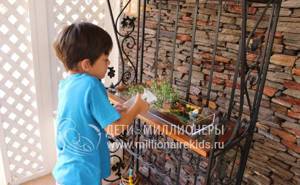
I also liked that Alexander himself was able to see how the sprouts turn towards the sun. Look what happened when the container was turned, the photos were taken an hour apart.
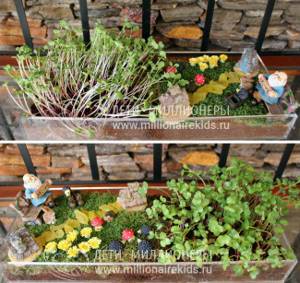
But most of all, the young agronomist was fascinated by the sight of growing roots. Every day he asked me to lift the box to see how they grew and wrapped around the soil. In my opinion, our “Grow a plant yourself” experiment was a success.
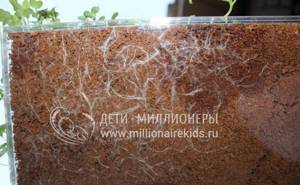
Watching my son, who is now 6 years 5 months old, I realized once again how important it is to gradually but constantly provide information to a child. I remembered a picture of the structure of a plant that he made at the age of 3. In its making, Alexander was also drawn to the roots.
If you are planning to grow plants with little ones, pay attention to our lesson on living and inanimate nature.
What will your children like?
In first place I put the set from the manufacturer 4M “Smart Plants”. We have used various educational materials from this brand and they are always aimed at interesting discoveries for children.
If you want to grow edible weed, you should pay attention to watercress in a neat pot.
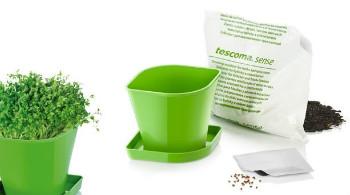
Have a good harvest!
Indoor hydrangea flowers: planting seeds and care
Indoor hydrangea is a compact perennial shrub that is covered with numerous ball-shaped inflorescences (Figure 8). If suitable growing conditions have been created for the hydrangea, it will bloom profusely and for a long time every year.
Planting and caring for indoor hydrangeas includes the following important points:
- Intense but diffused lighting, for example, a pot can be placed a few meters from the south window.
- The comfortable temperature for hydrangea is +20 degrees, but it feels good even with a slight decrease or increase in indicators. The main thing is that there are no drafts or sudden temperature changes in the room.
- After flowering is completed, a dormant period begins, which lasts until approximately February. At this time, it is better to transfer the flower to a dark, cool place and store it until the buds awaken. After this, you can return the hydrangea to its usual conditions.

Figure 8. Growing indoor hydrangea
In addition, hydrangea requires fairly abundant and frequent watering. In summer it is carried out more often, in autumn it is gradually reduced, and in winter it will be enough to add moisture only once a week. Hydrangea also needs to be sprayed frequently to increase air humidity. Ordinary jars of water placed next to the flower pot will also help to cope with this task.
Useful tips for beginners
Here are some useful tips for beginning gardeners:
- Be careful when choosing colors for your home, especially if you have children or pets. Study all the features of a particular instance, its pros and cons. Also evaluate the possibility of organizing optimal microclimate conditions.
- For planting, use fresh nutrient soil, prepared in accordance with the biological characteristics of the plants.
- When you bring a new representative of the flora home, do not place it immediately next to existing specimens - the substrate and the plant itself may contain fungal spores and pests that are invisible to the naked eye.
- When the first symptoms of disease and pest damage are detected, you need to remove the infected specimen to another room, carry out appropriate manipulations to eliminate the problem and treat all healthy flowers with preventative agents.
Proper planting of domestic flora representatives is a determining factor in maintaining consistently high resistance of the plant organism to diseases and pests. The main task of the florist is to adhere to the basic rules of agricultural technology.
